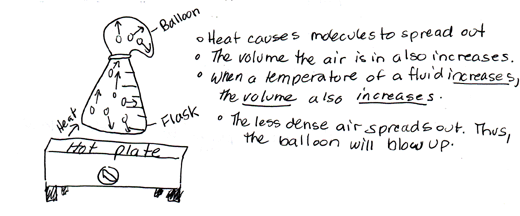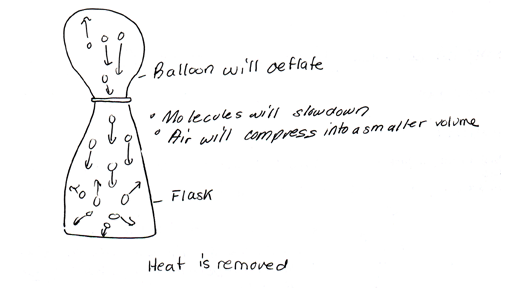Air Pressure Curriculum
Section 3—Lesson 8: What is Charles' Law and How Does it Involve Relational Causality?
Lesson Plan
Materials
- Erlenmeyer flask, 250 ml, 1 per class
- Hot plate, 1 per class
- Tongs, 1 per class
- Balloon, 1 per class
Prep Step
- Review the lesson plan, background information, and understanding goals.
- Set out the hot plate and other materials.
Analyze Thinking
Step 1: Considering the Relationship Between Pressure and Temperature
Ask the students to think about what happens when molecules are heated. They should draw a picture illustrating what they think will happen.
If the molecules are heated while they are contained in a constant volume, what do students think will happen to the pressure? Will it stay the same, go down, or go up? Gather some ideas. What are they basing their predictions on?
RECAST Thinking
Step 2: Exploring the Relationship Between Heat and Volume When Pressure Remains Constant
Explain that the students will watch a demonstration that reveals information about the relationship between temperature and volume.
- Place a balloon over the opening of an empty flask and set the flask on the hot plate. Begin heating the flask.
- Tell students to predict what they think will happen by developing a model on paper or individual white boards.
- Ask several students to put their models on the board for the class to discuss. As they are doing this, have the class also observe what is happening to the balloon on the flask. (As the air inside the flask is heated, the particles move around more quickly. This causes the air to expand within the balloon/flask system. Thus the balloon should inflate.)
- As students watch, they should note whether their observations conflict with their predictions. If so, they should revise their models accordingly.
- Using tongs, place the flask onto a heat resistant counter to cool. As the flask cools, students should observe the balloon deflate.
Explore Causality
Step 3: Considering How Relational Causality Explains Charles' Law
- Ask the class to reflect on what they observed.
- Ask: "Is air pressure related to temperature? If so, how?" Remind students to think of obvious as well as non-obvious causes.
- Encourage students to draw a new model or revise their previous models. Have several students share their ideas and/or models with the class.
| Examples of Students' Models | ||
|
||
|
- Ask: "Did you see any patterns in your observations? Did the air pressure change as the flask was heated?" (No, that was why the balloon inflated or deflated... to maintain equilibrium.)
Note to Teacher: Note whether any student mentions a relationship between the volume and the temperature. If they do not, ask them if they see any relationship between the two.
- Explain that scientists notice that volume and temperature are related, and they describe the relationship in a rule called Charles' Law.
- Charles' Law predicts that if the temperature of a fluid increases, the volume also increases (in a non-rigid container), thus pressure remains constant. In this activity, heating the air within the flask caused the molecules that make up the air to move at a faster rate. Thus they hit the sides of the container more frequently and the balloon inflated. When the flask was put onto the heat resistant counter, the molecules cooled, causing the balloon to deflate.
- Make sure that students understand that Charles' Law can be applied to most systems, however, in some systems, air pressure may not remain constant. (Charles' Law can be used to predict what will happen to the volume of a fluid when the temperature is changed in order to maintain a constant pressure.) This law only holds for 'closed systems', so make sure students understand this. (A closed system is defined as a system where there is no exchange or interaction with the outside environment. Technically, no system is ever truly closed. Rather, systems are open or closed as a matter of degree and in terms of how we define the parameters that we are interested in controlling.)
Review, Extend, Apply
Once the class understands the dynamics of what occurred within the flask, have them ponder whether the outside air pressure had any effect on what they observed. (Students may note that before the balloon was placed on the flask, the pressure of the air inside the flask was the same as the pressure of the air outside the flask. When the air was heated inside the flask, its pressure increased, and in order for it to equilibrate with the outside air pressure, the balloon had to increase in volume... it inflated. When the flask was cooled, the air pressure inside the flask decreased until it was equal to the outside air pressure, and thus the balloon deflated.)
Ask students to think about possible connections to what they just learned. For instance, what if they are riding their bicycles a long distance, or on a very hot day? If they checked their tire pressure, would they get the same reading before and after the long ride?
Note to Teacher: The reinforcement activity, What Causes the Balloon to Get Pushed/Pulled Into the Flask?, offers a nice extension for this lesson.




